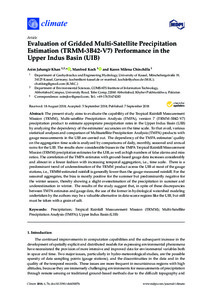| dc.date.accessioned | 2019-01-31T09:19:54Z | |
| dc.date.available | 2019-01-31T09:19:54Z | |
| dc.date.issued | 2018-09-07 | |
| dc.identifier | doi:10.17170/kobra-20190130122 | |
| dc.identifier.uri | http://hdl.handle.net/123456789/11045 | |
| dc.description.sponsorship | Gefördert durch den Publikationsfonds der Universität Kassel | |
| dc.language.iso | eng | |
| dc.rights | Urheberrechtlich geschützt | |
| dc.rights.uri | https://rightsstatements.org/page/InC/1.0/ | |
| dc.subject | Precipitation | eng |
| dc.subject | Tropical Rainfall Measurement Mission (TRMM) | eng |
| dc.subject | Multi-Satellite Precipitation Analysis (TMPA) | eng |
| dc.subject | Upper Indus Basin (UIB) | eng |
| dc.subject.ddc | 620 | |
| dc.title | Evaluation of Gridded Multi-Satellite Precipitation Estimation (TRMM-3B42-V7) Performance in the Upper Indus Basin (UIB) | eng |
| dc.type | Aufsatz | |
| dcterms.abstract | The present study aims to evaluate the capability of the Tropical Rainfall Measurement Mission (TRMM), Multi-satellite Precipitation Analysis (TMPA), version 7 (TRMM-3B42-V7) precipitation product to estimate appropriate precipitation rates in the Upper Indus Basin (UIB) by analyzing the dependency of the estimates’ accuracies on the time scale. To that avail, various statistical analyses and comparison of Multisatellite Precipitation Analysis (TMPA) products with gauge measurements in the UIB are carried out. The dependency of the TMPA estimates’ quality on the aggregation time scale is analyzed by comparisons of daily, monthly, seasonal and annual sums for the UIB. The results show considerable biases in the TMPA Tropical Rainfall Measurement Mission (TRMM) precipitation estimates for the UIB, as well as high numbers of false alarms and miss ratios. The correlation of the TMPA estimates with ground-based gauge data increases considerably and almost in a linear fashion with increasing temporal aggregation, i.e., time scale. There is a predominant trend of underestimation of the TRMM product across the UIB at most of the gauge stations, i.e., TRMM-estimated rainfall is generally lower than the gauge-measured rainfall. For the seasonal aggregates, the bias is mostly positive for the summer but predominantly negative for the winter season, thereby showing a slight overestimation of the precipitation in summer and underestimation in winter. The results of the study suggest that, in spite of these discrepancies between TMPA estimates and gauge data, the use of the former in hydrological watershed modeling undertaken by the authors may be a valuable alternative in data-scarce regions like the UIB, but still must be taken with a grain of salt. | eng |
| dcterms.accessRights | open access | |
| dcterms.creator | Khan, Asim Jahangir | |
| dcterms.creator | Koch, Manfred | |
| dcterms.creator | Chinchilla, Karen Milena | |
| dc.relation.doi | doi:10.3390/cli6030076 | |
| dc.type.version | publishedVersion | |
| dcterms.source.identifier | EISSN: 2225-1154 | |
| dcterms.source.issue | 3 | |
| dcterms.source.journal | Climate | |
| dcterms.source.pageinfo | 76 | |
| dcterms.source.volume | 2018, 6 | |

